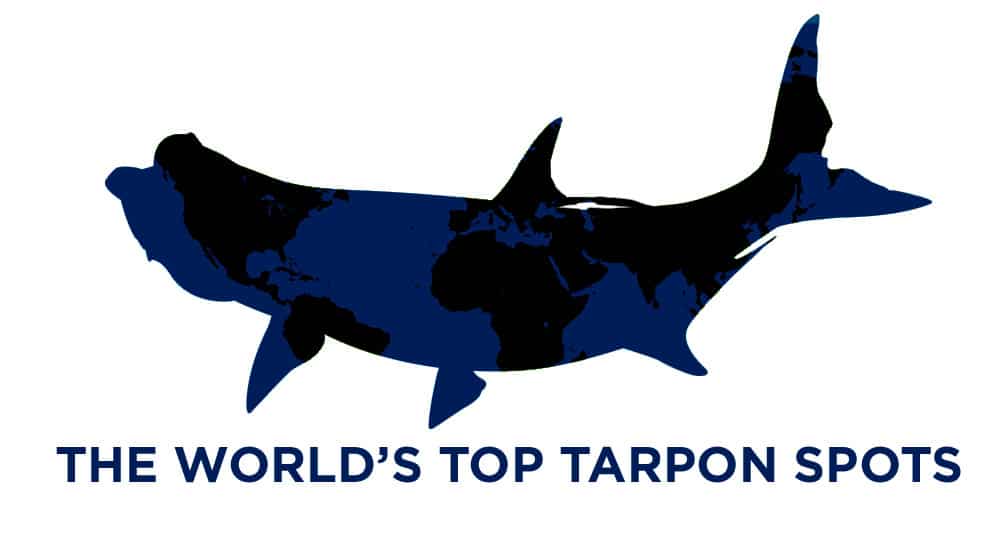
Welcome to the world of tarpon, one of the most sought-after game fish. These fish live in estuaries and near-coastal waters off river mouths and beaches, and in channels, passes and bays on both sides of the Atlantic. All of those habitats are represented in this list of the best tarpon fishing locations, with expert tips on how to catch them. This list isn’t inclusive, but it offers a look at many of the world’s top bets for great tarpon fishing and may offer some ideas for where to plan your next trip to take on one of the world’s top game fishes by any measure.
Tarpon Fishing in Boca Grande, Florida

The high-visibility fishery in famed Boca Grande Pass is a great show but hardly the only one in town for tarpon fishing enthusiasts. Certainly, drifting through the deep pass and slowly working jigs produce loads of fish in this tarpon-rich area. But in fact, tarpon swarm around Boca Grande Island and the entire Charlotte Harbor area from April through October (May through September is peak). Tarpon-guide emeritus here, Capt. Mark Bennett (Tarpon Snook), years ago stopped fishing the pass in favor of the clear, shallow waters in bays, flats, backcountry estuaries and off beaches.
The pass itself still offers some incredible fishing, but you must often be able and willing to fight for elbowroom. The gunwale-to-gunwale throngs of boats of all sizes and shapes that stretch across the path make for a unique experience, variously harrowing and exhilarating, particularly when several large tarpon begin jumping simultaneously among (and sometimes right into) the boats. Suffusing the waters well away from the pass are the same big (80- to 120-pound) silver kings, with some 200-plus fish definitely around. If sight-casting to fish that size doesn’t send your heart racing, better check for a pulse.
Clearly, the Boca area is a great venue for fly-rodders as well as anglers throwing artificials such as MirrOlures, D.O.A. Baitbusters, Hogys and the like; still, live crabs, threadfin, pilchards and pinfish are tough to beat. Plenty of ops for inshore slams abound, with snook, redfish and seatrout in great supply. The closest major airport is Fort Myers; places to stay and eat and things to do are all pretty much unlimited.
Tarpon Fishing in Key West, Florida
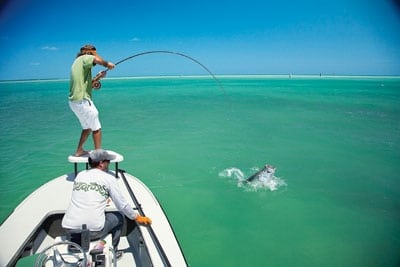
Weather. It’s the word that one of the Keys’ best-known veteran inshore guides, Capt. Tom Rowland (Salt Water Experience), comes back to over and over. That’s because it’s a critical factor for success and because “if the conditions are good, I can catch tarpon out of Key West almost any day of the year.” The Key West area hasn’t developed a reputation as one the world’s premier tarpon fishing spots without good reason. “It’s a unique and awesome tarpon fishery,” Rowland says. “We can catch tarpon by just about every imaginable method and every situation in the Keys.
For example, an angler fishing right in Key West harbor with an expert like R.T. Trosset, who chums them up, may hook as many as 50 tarpon in one tide.” Impressive — if less dramatic — numbers are likely for anglers fishing popular tarpon lures or casting flies. If you want beaucoup light-tackle action, you can find lots of aggressive 5- to 40-pounders throughout the year. But for the big bruisers, those averaging in the vicinity of 80 pounds, plan to fish February and March, and some years right into June.
You certainly don’t have to travel to Africa for huge fish. “I’ve guided anglers to many tarpon over 200 pounds, and some of those on fly,” says Rowland. Also, unlike west Africa, Key West does offer opportunities to sight-cast flies to tarpon in clear, shallow water. If the heat of summer gets oppressive, try tarpon fishing at night; it’s cool and often extremely productive. Several major airlines fly directly into Key West from southeastern cities. Places to stay and eat and world-class guides with top-shelf boats abound.
Trinidad
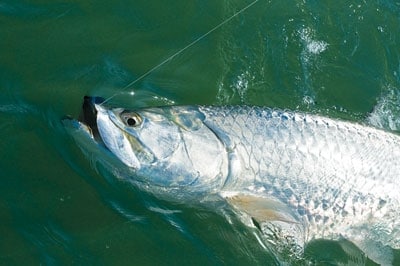
Where the northwest corner of Trinidad reaches out to practically kiss the coast of Venezuela sit four small islands; tidal currents surge through channels in and around them, providing happy feeding grounds for tarpon and happy fishing grounds for what is arguably the Caribbean’s best silver king action. June through November is all prime time to fish Trinidad, which offers both quantity and quality. Capt. Frothy De Silva (Hard Play) says a decent half-day of fishing should provide six to 12 hookups from fish of 40 to 100 pounds and often larger. Nearly every season, De Silva says, a dozen or so tarpon topping 200 pounds are released.
After a mere 10- to 15-minute run from the Trinidad and Tobago Yacht Club, De Silva has live baits out — “goggle-eyes, snappers, grunts, anything we can sabiki up.” Then he puts out a six-line spread in what he calls “uptiding,” deploying two 30s on outriggers fished far back; two 50s on downriggers at 20 and 40 feet; and two flat lines.
De Silva positions the boat into the current and coaxes tarpon up by throwing out live chum. “It’s been a very successful method for me.” The roiled waters are far too opaque to spot fish beneath the surface, but it’s not unusual to see hundreds of tarpon rolling in a long line. Trinidad’s Tarpon Thunder Tournament takes place each August. Major airlines fly daily into Piarco International Airport.
Update: A reader informed Sport Fishing that Capt. Frothy De Silva no longer operates in Trinidad for tarpon. An updated contact for tarpon fishing opportunities is Island Yacht Charters.
Rio Colorado, Costa Rica

From personal experience, I’d have to say that fishing outside the Rio Colorado River in the fall offers the closest thing to guaranteed tarpon action an angler will find. Fishermen often catch tarpon all day along the conspicuous current lines that may run for miles where green ocean waters butt up against brown river outflow. These “outside tarpon” in the fall average 80 pounds or so. No clear-water sight-casting or anchoring up with live baits here. Rather, anglers mostly troll lures or work jigs from a drifting boat.
Listen to the chatter back at the lodge over dinner; rare are anglers who don’t enjoy multiple shots each day, often well into double digits. The ocean generally remains blessedly calm during this time, but periods of heavy rains often move through. Fortunately, the river and resorts are within a short run. During the dry months of January through May, it’s a different fishery, primarily trolling Rapalas, MirrOlures and Coasthawk jigs inside the river itself. Snook offer the main alternative to tarpon fishing here, and trophy fish can be taken year-round in the surf at the river mouth. During the winter, the lower river can be chock-full of what are known locally as calba snook.
While these average only a few pounds or so, you can wear yourself out catching and releasing them all day. To get here, fly into San Jose (served by many major air carriers), overnight in the city and then catch a small plane for a flight of an hour or so to the little landing strip. For more information, visit Archie Field’s Rio Colorado Lodge.
Angola

Angola is Tom Gibson’s favorite tarpon-fishin’ hole these days. “So what?” you may wonder. Just this: It’s unlikely that anyone, anywhere, has logged more miles and hours all over the world in search of great tarpon fishing than Gibson, of Houston. Consider west Africa alone, which he’s visited on at least 40 different trips since 1980. (Gibson’s records document 79 tarpon exceeding the 200-pound mark — all but three taken in African waters.)
Unlike some other west African hot spots, Angola seems to have more small tarpon in addition to the usual 80- to 130-pound fish, which can reduce the time between strikes. But Angola remains a good bet for true giants, October through April (December through February is peak); for example, just last February, Gibson released an estimated 225. This is another “blind” fishery with the best fishing outside the river. Few tarpon can be seen rolling, but they’re there. IGFA rep and Angola resident Iain Nicolson says live baits such as sardines, bumpers and small jacks provide the best action.
While targeting tarpon, expect the occasional cubera snapper to 100 pounds and the odd giant African threadfin. On his last trip, Gibson caught his first threadie, nearly 90 pounds. He says he’s never felt threatened during any of his trips to Angola and considers it a safe destination. Fly into Luanda via Europe; then allow 1.5 hours in traffic for the 40-mile drive to the coast, where you’ll find a fish camp with air-conditioned cabins and good boats/guides through Angolan Adventure Safaris.
Gabon

“For the fisherman [seeking big tarpon] who is also a naturalist and thrives on wild places, Gabon is one of the most special places on earth.” Edward Truter, a South African fishing writer who’s been all over the world, spent several years in Gabon. He says the country offers several excellent tarpon fisheries, all centered on river or lagoon mouths. No ops for sight-casting in the muddy, choppy waters, but using live bait, jigs and lures provides opportunity for large fish of 80 to 160 pounds.
On a good day, Truter says, expect six to 10 shots from fish that size, with the odd 180 to 200-plus an ever-present possibility during the peak period, late October through early January. Pluggers work jigs and plastic tails, Rapala floating minnows or twitchbaits as well as poppers. However, the best baits, especially for big-fish battles in Gabon, are live herring or mullet. Other exciting game fish such as giant threadfin and huge cubera feed in the same areas.
Loango Lodge at Loango Iguela Lagoon offers a first-class facility. To the south, at Sette Camam, are Missala Lodge and Sette Cama Safaris, a bit more rustic but very well set up to accommodate sport fishermen. Truter considers Gabon quite safe to visit as long as you’re mindful of malaria prophylaxis and take care when fishing rough river mouths. Fly into Libreville via Europe on Delta, Air France and others.
Guinea-Bissau
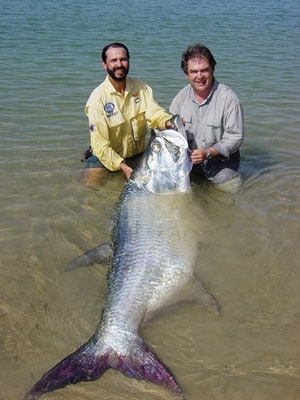
When it comes to tarpon, Guinea-Bissau can back up its contention of giant fish with this claim to fame: The IGFA all-tackle world-record tarpon came from this country in 2003. It weighed 286 pounds, 9 ounces. Like some other “quality fisheries,” however, you have to be motivated and patient. “It’s not about several bites per day, as in Florida; it’s about several bites in a week in GB,” says Patrick Sebile, internationally known lure designer/manufacturer and GB tarpon guide for years (who guided angler Max Domecq to his first-ever tarpon, that 286-pound world record).
Anglers can fish tarpon year-round with live bait on 400-pound leader and big circle hooks from boats anchored nearshore in the Atlantic. But the biggest fish show up during the February-March run of bongas (shad) inside estuaries along the north coast. Sebile’s meticulous records show tarpon caught in this fishery running an impressive 200 pounds plus. Rolling fish here don’t bite, says Sebile, but it’s an “incredible spectacle” to see hundreds of 200-pound tarpon rolling for hours.
Big tides here may necessitate long runs when extensive sandbars become exposed. Fly directly into Bissau via Portugal. Visit the Acunda Island Fishing Club, or e-mail contact@atlantic-evasion.com.
Sierra Leone
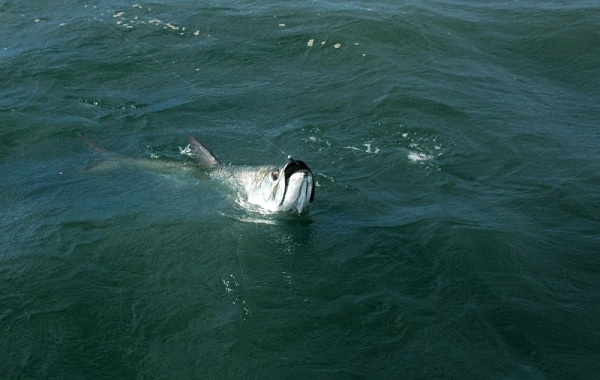
Civil war can be so inconvenient. Just when Sierra Leone had very clearly established itself on the map as giant-tarpon HQ in the 1990s, racking up record after record in the IGFA book, five years of civil war starting in 1999 stopped the show. But it must go on, of course, and now, in more peaceful times, anglers have begun to return.
The fishing camp at Bonthe on Sherbro Island accounts for about half of all IGFA line-class-record catches. It’s very wild, primitive and one of the most beautiful of all the African coasts, says Julien Lajournade, editor of the French fishing-travel magazine Voyages de Peche who guided for years at Sherbro.
It’s an adventure “not for the average angler,” he says. Like Guinea-Bissau, fishing for big tarpon here is often a waiting game. Fish late February through early June. Fly BMI into Lungi International Airport in Freetown from London, then via chopper, small plane or taxi to Bonthe and by boat downriver to Sherbro.
Yucatan Peninsula
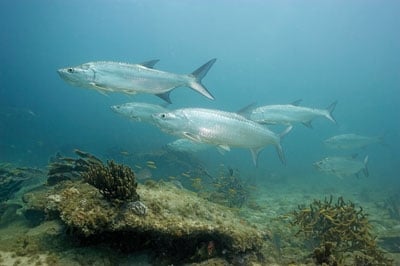
For tarpon enthusiasts, the Yucatan offers the best of both worlds: trophy-size fish migrating through in deeper water around Holbox Island and resident tarpon prowling the shallow flats and mangroves around Isla Blanca. Connect with the kings at Blanca any month of the year (even when breezy, you can generally find protected areas), and sight-cast to individual targets. Holbox offers a prime summer fishery when you can cast into areas of fish in the 80- to 100-pound range, with some to 150, rolling in deeper water.
Lighten up and take advantage of schools of baby tarpon in the mangroves. Most guides here cater to fly-rodders; the preferred-fly list of Fishing International’s Bill Hutchinson includes Purple Death, Black Death, Seaducers, Toads and Clousers. Rapalas and plastic swimbaits also work. Isla Blanca is fishing grand slam country, with permit numerous and lots of small bonefish; in the mangroves, snook consort with the little tarpon. Fly into Cancún; then continue via car and boat to the island. For more information, visit Fishing International or Isla Holbox Tarpon Club.
Brazos Santiago Pass, Texas

Texas then, says tarpon skipper Capt. Vere C. Wells: “When the Rio Grande still flowed, and you literally couldn’t see the end of tarpon schools that went on for miles.” Texas now, according to anecdotal evidence, says biologist Mark Lingo with Texas Parks and Wildlife: “Those who fish for ’em tell me tarpon populations are better now than they’ve been in decades.”
You’ll see 60- to 120-pounders rolling, says Wells, who’s guided here since the 1960s, with fish to 150 mixed in (bigger fish more likely in fall). “These fish are spooky,” Wells advises. Most are caught bouncing bottom with circle-hook lead-heads and swimbait tails of the Coon Pop variety, or for a pretty sure bet, fish live mullet, early/late in the day or around tide changes. For more information, call Wells at 956-551-3483.
Homosassa, Florida
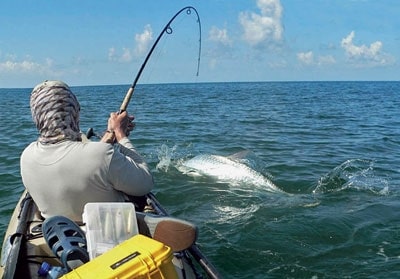
Though less well known than Boca Grande, about 150 miles to the south, the Homosassa/Chassahowitzka area can be a hotbed of tarpon activity, spring through fall. Even when tarpon are thick, the vast, pristine Chassahowitzka Reserve may remain largely deserted. “Sometimes, we fish without seeing another boat all day,” says Capt. William Toney (Homosassa Inshore Fishing). At times, the best tarpon action will be in the Homosassa River in pools as deep as 18 feet. Most often, though, this is also a great sight-casting fishery, over outside flats in a few feet of clear water.
As in the Boca area, look for an 80- to 120-pound average; Toney’s biggest to date was just shy of 200. He caught it on one of the top Homosassa silver king producers — not live bait, but a Bomber Long “A” plug. D.O.A. Bait Busters and Swimming Mullet, and MirrOlure MirrOdine XLs also rate as top producers.
See How Lures Swim: Bomber Magnum Long A
See How Lures Swim: MirrOlure Mirrodine XL
For fly guys, a Toad in chartreuse/yellow or black/purple gets results. At times (particularly in the spring), cobia can make very welcome incidental targets on the same flats.
Miami, Florida

Every winter, about the time tourists flock to Miami Beach, tarpon show up as well. They provide a remarkable urban fishery just off beaches crowded with sunbathers. One of the best-known tarpon skippers for decades, Bouncer Smith (Capt. Bouncer), says tarpon fishing remains “solid” from about mid-December (some years, weeks earlier) to mid-June (some years, weeks later). Smith looks for the fish in 12 to 20 feet of water, typically.
Free-lined live shrimp account for most of the tarpon hooked up through about mid-April; then live crabs become the best bet among baits for the duration of the season. But anglers can do well casting lures (Rattlin’ Raps, D.O.A. Shrimp, Gulp! Swimming Mullet) or flies (Deceivers) to rising fish in the winter or rolling fish in the spring. In late fall and early winter, the tarpon average 50 or so pounds; by February, that average goes up considerably, with fish to at least 150 caught every year.
Southern Louisiana

It’s tarpon anglers, not tarpon, who have become scarcer in recent years in Louisiana waters, says Capt. Brandon Ballay (Venice Outdoors). He attributes that to extensive coverage of the great offshore fishing for (very edible) pelagic game fish like yellowfin tuna and wahoo. But tarpon are abundant generally, and especially August and September, in any of four spots: Southwest Pass, the mud lumps off South Pass, the West Delta and the Grande Bayou area, all roughly a 35- to 45-minute run from Venice. Guides such as Ballay play the tarpon game strictly with breakaway 1- to 2-ounce Coon Pop-style jigs and tails. Cajun tarpon average 120 pounds or so, but Ballay says, “On a good day, an angler can release five or six, one of which is likely to be 170 pounds or so.”
Puerto Rico
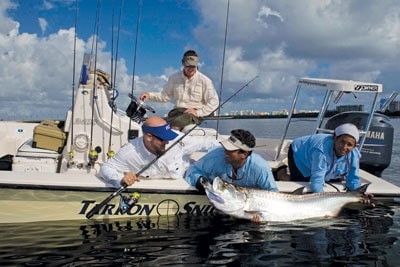
The silver king fishing in PR is good enough for longtime guide Capt. Omar Orraca (Fishing in Puerto Rico) to guarantee at least a shot at tarpon every trip, all year (he claims 92 consecutive trips landing at least one tarpon). That said, spring and fall offer peak periods in local lagoons when 20 strikes on live baits during six hours of fishing is not unusual. Orraca says the tarpon run 15 to 40 pounds in the fall and 60 to 80 in the spring.
A 10- or 15-minute boat ride from Old San Juan in the heart of the city puts anglers in tarpon-filled lagoons where waters are calm but acidic and dark; rather than sight-cast to individual targets, anglers throw into feeding frenzies that frequently erupt at the surface. PR tarpon have a fondness for root-beer D.O.A. TerrorEyz and big Clouser Minnow flies. Live anchovies, threadfin and sand perch all work. These lagoons hold plenty of snook also. Fly directly into San Juan; a plethora of fine hotels is just a short taxi ride from the Congrejos Yacht Club where Orraca docks.








